The Old Dutch Church
Kingston, New York
Compiled by James W. Werner
Click on any photo below to see it full size!
The Old Dutch Church on a 1901 postcard
The steeple.
The first stone Church 1679 - 1752
Pictured before the doop huys was added in 1721
The second stone Church 1752 - 1832
Pictured as restored after it was burned in 1777
1808 Survey of the Old Dutch Church property
Showing the location of the second stone church on the corner of Wall and Main Streets.
1695 Map of the Stockade
Map of Kingston in 1777
Map of Kingston in 1820
The Old Dutch Church from Main Street in 1936
The corner of Wall and Main Streets in 1904.
The corner of Wall and Main Streets in 1934.
The corner of Wall and Main Streets, present day.
The interior of the church in 1907
The Church in September 1901
A sketch drawn in 1860 from the corner of Pearl and Fair Streets showing
the church as it looked after the steeple blew down in 1853. The spire of St. John's Episcopal church on Wall Street is in the background.
The interior of the church in about 1950? Current view of the interior
The 1883 addition.
Detail of the marker dated 1752 set in the 1883 addition.
Detail of the beautiful ceiling
Detail of the interior of the attic and the top of the 45' beam that is inside of each column
Detail of the lath and plaster above the vaulted ceiling
Names on a beam in the attic that seem to date back to 1883
An early view of the Hurley Reformed Church
The Old Dutch Church Sanctuary decorated for Christmas
Looking towards the choir loft and the beautiful organ
The east side of the church and part of the cemetery
The front entrance
The Wall Street entrance and the base of the steeple
The front entrance on Main Street
The steeple
The east wall and the temporary bracing pending repairs
The Old Oak Chest from 1676 as it looks today!
The 1683 and 1711 engraved silver communion beakers!
The odest stone in the Churchyard - 1710!
Watercolor of ODC
History of the Early Settlement of Kingston
Kingston was the first capital of New York State and was originally known as Esopus. Later, for a few years, it was renamed Wiltwyck (meaning "wild refuge") by Peter Stuyvesant. In 1664 New Netherlands passed from Dutch to English control and the settlement was permanently named Kingston. Thomas Chambers, a red-headed English carpenter, and a few neighbors unhappy with economic and political restrictions to the north in Fort Orange, settled here in 1652. Esopus was the 3rd settlement in New Netherlands after New Amsterdam (New York) and Fort Orange (Albany).
The early history of the area is reflected in an excerpt from Kingston Gateway to the Catskills printed in August, 1931 by the Kingston Chamber of Commerce: "authentic records establish the construction of a small fort at Ponckhockie, now the 5th ward of Kingston City, as early as 1615, only six years after Hudson's discovery. From that time on there was always a trading post or settlement here until 1658, when Peter Stuyvesant laid out the site of what is now Kingston and ordered it to be surrounded by a Stockade."
In September of 1609, Henry Hudson, on his ship the Half Moon, sailed into New York harbor and proceeded to explore the Hudson River valley as far north as present day Albany. Hudson was sailing for the Dutch East India Company and did some trading with the local natives which helped the Dutch establish a claim to this area of New York. In 1614, a Dutch trading post was established at Rensselaerswyck (now Albany) to further the prosperous fur trade.
Alphonso T. Clearwater in The History of Ulster County (1907) writes;
The Dutch traded at Kingston Point as early as 1613, and left some boats there in 1621-22. No permanent occupation seems to have been made, so far as appears from any manuscript records, prior to 1652. In that year Thomas Chambers, an Englishman by birth, with a colony of settlers from the Manor of Rensselaerswyck, began a permanent occupation of the region of the Esopus, presumably by consent of the aborigines or by purchase of farms from them.
Rev. Johannes Megapolensis and Rev. Samuel Drisius, writing to the Classis of Amsterdam, (Ecclesiastical Records of New York) in August, 1657, refer to Esopus as follows:
"About eighteen [Dutch] miles [about 54 English] up the North River, half way between the Manhattans and Rensselaer or Beaverwyck, lies a place called by the Dutch Esopus or Sypous and by the Indians Atharhacton [Atkarkacton]. It is an exceedingly fine country there. Thereupon some Dutch families settled there, who are doing well."
The following history of the early settlement was taken from the 1860 edition of the Gazetteer of the State of New York by J. H. French.
"The Dutch built a trading and military post (redout in Dutch) upon the present site of Rondout as early as 1614 (only a few years after the visit of Henry Hudson) and probably a few Dutch families settled in the immediate vicinity soon after. The site of the first Dutch fort is said to be upon a plateau in the w. bounds of Rondout. The locality is still called by its Indian name, Ponkhockie, said to signify "Canoe Harbor." This early settlement was broken up by Indian hostilities and was swept away in the wars of 1644-45. Another settlement was commenced in 1652. This was again attacked by the Indians, and in 1655 was also abandoned."
"Before 1660, settlers had again located 2 miles inland at Esopus and vicinity. Called by the Indians "Atkankarten," - said to signify smooth land. It was more commonly called Esopus, from a tribe of Indians that inhabited it. Because of repeated attacks by the Indians, Governor Peter Stuyvesant ordered a stockade built in 1658 and all settlers were to move their homes within its walls. This fence enclosure was 14 feet high and had guard houses at various locations. As the population grew the stockade was expanded several times."
"Gov. Stuyvesant granted the village a charter, May 16, 1661, under the name of Wiltwyck, and relieved it from dependence upon Fort Orange. Its affairs were to be managed by a sheriff and 3 schepens. Roeloff Swartwout was appointed first sheriff, and Evert Pels, Cornelius Barentsen Sleight, and Elbert Heymans Roose, the first schepens. Appeals from their decisions might be made to the Director General and Council in New Netherlands. The sheriff and commissioners were to hold a court every fortnight, except in harvest time, unless occasion or necessity might otherwise require."
"In 1660 a treaty had been concluded with the Indians; and the people were so unsuspicious of danger that they left open the gates to their fort both day and night. After the peace of 1660 the Director General of New Netherlands had shipped 11 Indians prisoners to Curacoa to be sold as slaves. This outrage led to the attack made in 1663, and the bloody war that followed."
"On the 7th of June, 1663, as most of the people were at work in the fields, the Indians came into the fort at Wiltwyck in great numbers, apparently to trade. At a given signal the Indians made a sudden attack upon the fort and commenced the work of destruction. Recovering from their first panic, the whites rallied, under the leadership of Thomas Chambers, and finally drove the Indians out of the fort; 18 whites were killed, and 42 were carried away prisoners. The out settlements were all destroyed."
"Nine days after the retreat of the Indians from the attack upon Wiltwyck, in June, 1663, a reinforcement of 40 men, under Ensign Myssen, arrived, and relieved the fort. Capt. Krygier, with a cannon and a force of 210 men, pursued the Indians to their forts and destroyed their grain. In Sept. another expedition surprised an Indian fort, 36 mi. southwest of Wiltwyck, killed the chief and 20 others, and restored 22 captives. The Indians were effectually broken and scattered, and late in the fall they sued for peace and restored all the remaining prisoners except 3."
To read a very interesting diary of these exploits check out the
Journal of The Second Esopus War 1663 written by Capt. Martin Kregier as the events unfolded.
Religous History
Organized in 1659, "The Reformed Protestant Dutch Church of Kingston, NY" familiarly known as "Old Dutch", is the 6th oldest Reformed Church in America, having a continuous ministry and worship on practically the same ground. The baptism and marriage records of Old Dutch, dating from 1660 (recorded in Dutch until 1810), are the most complete and among the oldest in the country still in existence. All services were in Dutch until 1809. Fifty (50) Reformed Churches, stretching from the east side of the Hudson River through the New Jersey/Pennsylvania border can trace their roots to Old Dutch. For 170 years it was the only church in Kingston.
Holland was a safe haven for victims of religious persecution in other lands, and those who came to New Netherlands were desirous of forming a church with a Dutch minister, called a Dominee, for their pastor. In 1658, a church was commissioned to spread the Gospel "both on the water and on the land, and in all the neighborhood, but principally at the Esopus". In 1660, Hermannus Blom arrived and on December 26th of that year administered the first Lord's Supper to his little flock of 17 members. A plaque in the sanctuary of the present church memorializes this first communion and lists the names of those in attendance. In 1661 a building was erected for a church inside the stockade, at the corner of what is now Wall and Main Streets where the old stone church subsequently stood.
A.T. Clearwater wrote in his History of Ulster County, "The first Church edifice was constructed of logs, in 1661, on ground now occupied (in 1907) by a barn of the late Augustus H. Bruyn. This first rude building was, two or three years later (1679), replaced by a commodious stone structure on the southeast corner of the present Church-yard."
Some believe that the first church, built in 1660 or 1661, was constructed of clapboards as it has been said that the Dutch never used logs for their homes. This structure was burned during an Indian raid in 1664.
In 1662 Governor Stuyvesant ordered the erection of a suitable parsonage. It was referred to as "the Dominee's Town House" and was built of stone with a roof of Holland tiles. Besides religious duties, it was used as a school, the court and other public purposes and civil affairs. On his 1695 Map, Since the land on which the church stands was a gift from Stuyvesant to the Church, it had no deed. The Consistory, led by Dominee Vas, petitioned the Governor of Her Majesties Provinces in 1712 to have the church incorporated. In addition to the church erected by the members, the petition stated they "have also purchased about half an acre of ground for a Cemetery or Church yard all at their own Charges & Expenses." This petition was not acted upon but another received favorable action. In November 1719 the Church was granted a Charter of incorporation by King George I, to be repaid with one peppercorn a year as rent. This payment was made until the American Revolution cancelled the debt.
The following paragraph offers an excellent, first hand, description of the village of Kingston as it existed in 1795. (Compare this description to the contemporary Kingston, or Esopus, a post-town of New York, situated on the W. side of Hudson's river, six miles W. of Rhinebeck, and on the E. side of Esopus Kill, or Creek. It was destroyed on the 15th of October, 1777, by order of General Vaughan, commanding a fleet which sailed up the Hudson, when large quantities of stores were consumed. It is rebuilt on a regular plan, and contains about 150 houses, a courthouse, jail, a Dutch Reformed church, and an academy. It is most pleasantly situated upon and surrounded by a spacious plain. It is 56 miles S. of Albany, and 109 N. of New-York......... The township contains 3929 inhabitants, of whom 556 are electors, and 302 slaves."
The street layout of the Village of Kingston in 1777 looked very similar to the uptown area we know today. On the The Patent of the Town of Kingston
In 1683 the General Assembly of the Province of New York enacted a law creating the County of Ulster and the Town of Kingston. The Village of Kingston became part of the larger Town of Kingston and subject to the town court and rules made by twelve elected Trustees. The Trustees of the Freeholders of the Town of Kingston formed the local government of the town in both civil and judicial affairs and were empowered by their charter to ordain rules and regulations for the good order of the Territory. Until the adoption of the State constitution select members of the Trustees wielded all the powers of a local court. They had to provide for the defense of their Frontier and arrange protection for the inhabitants from attacks by Indians and Tories.
In May, 1687, Governor Thomas Dongan, the governor of New York Province under the reign of King James, issued a patent or grant of a large territory of land to the Trustees of the inhabitants of the Town of Kingston (which included the Village of Kingston). This Patent extended from the southerly bounds of Albany (which was then near Sawyer's Creek in Saugerties), to the Little Esopus Creek (near Klyne Esopus) and west to the bounds of Hurley and then following the mountain range north to the bounds of Albany. The Patent gave the Trustees control of all the unimproved and not previously granted land within the Town and they began reviewing applications and granting property at their first meeting.
From the beginning, the Trustees liberally funded education and religion. The Trustees particularly supported the Old Dutch Church of Kingston by a donation of land. A deed was recorded in May of 1809 transferring several parcels totaling just over 1000 acres in the Northern part of the Patent to the Church. These lots were all located on the south side of the "MuddersKill" and east side of Kings Highway (deed 19-531). It was disposed of by the Consistory in parcels as needed for the support of the church.
In March 1778, the Trustees received a letter from Chancellor Robert Livingston expressing his sympathy for the residents of Kingston who had lost their homes to the fires set by the British the year before. Livingston offered to the Trustees a grant of 5000 acres in the Hardenburgh Patent to be disposed of in such a way as will be most advantageous to the "suffering inhabitants of Kingston". The Trustees at once chose a tract at a place known as the Plattekill and ordered a survey to be commenced. A deed was received from Chancellor Livingston in October of 1779 (deed HH-64) and subsequently, under the direction of the Trustees, the tract was divided into 100 lots of 50 acres each and allotted to the heads of the families who had suffered the most in the fire.
In 1783, the Congress was looking for a permanent location for the capital of the new nation and the Trustees of Kingston thought their town was the most appropriate spot. They forwarded a letter by New York Governor George Clinton to Philadelphia for presentation to the Congress of the Confederation offering one square mile of their land for use as the seat of Government of the United States. Upon learning that the Legislature of Maryland offered the cession of the city of Annapolis to Congress for their permanent residence, the Trustees of Kingston increased their offer to two miles square. Our present Federal Government could have been located here on the Hurley flats but Congress took no action on the subject at that time and later chose the area where the District of Columbia is now.
In 1803 the Trustees of Kingston resolved to sell all the lands granted to them by their Charter of Incorporation that had not yet been conveyed except for the land between the east bounds of the town of Hurley and the north side of the Rondout Creek (the Binnewater and Eddyville area today). They hired two surveyors to map these remaining patent lands and to lay out lots of 30 and 45 acres each. Every person and head of household residing in the Town of Kingston was entitled to purchase a lot at a price established by the Trustees. It appears that the inhabitants of the Village of Kingston did not fare as well as other residents of the town and felt their lots were inferior in quality. In 1804, the Trustees resolved that the lands reserved from the earlier resolution be laid out in ten acre lots and conveyed to the residents of the village as compensation. The Trustees also conveyed several hundred acres that had previously been reserved for the benefit of a college or university to the Trustees of Kingston Academy.
In April 1805 the Village of Kingston was incorporated as a separate body and in 1811 a New York State law was passed that divided the Patent of Kingston and created the town of Saugerties on the north, and the town of Esopus on the south. The Board of Trustees had accumulated a considerable fund in the treasury from the sale and disposition of their lands and in March of 1805 chose to transfer most of the corporate funds to the three churches in the area. Over 3000 Pounds were dispensed to the Reformed Protestant Dutch Church of Kingston, 1740 Pounds assigned to the Reformed Dutch Church at Caatsbaan and the sum of 1260 Pounds was assigned to the Reformed Dutch Church at Klyne Esopus. Finally in 1816, after nearly 130 years, the Patent of Kingston was dissolved and the records and maps were transferred to the custody of Christopher Tappen, the Ulster County Clerk, who assumed the responsibility for recording future land transactions. The remaining corporate funds were divided between the towns of Saugerties, Esopus and Kingston for use by the overseers of the Poor.
The First Stone Church (1680 - 1752)
According to A History of Kingston by Marius Schoonmaker, in 1679 a "handsome new church, 60 feet long and 45 feet wide" was erected near the corner of Wall and Main streets. Built of rough limestone, the walls were three to four feet thick. Described as "highly finished" the building was decorated with colored glass windows bearing the Dutch coat-of-arms. This church was dedicated on January 1, 1680 and was used until it was torn down in 1832 (or 1836).
The first minister to preach in this stone church (and the third minister since the church was organized) was Johannes Weeksteen who arrived in 1681. Domine Weeksteen was plagued by poor health and ministered to the congregation until his death on March 17, 1687. According to Nathaniel Sylvester in his History of Ulster County, Johannes Weeksteen was "buried, according to the custom of the day, under the church in which he had preached". Another Dominie, George Mancius, who served with Petrus Vas from 1732-1762 was also "buried under the church, near the elders seat" when he died on September 6, 1762. Dominie George Doll was called to serve the congregation in 1775 and did so until his retirement in 1808. Dominie Doll died at the home of his sister in Kinderhook on March 28, 1811. Sylvester reports
"The Church ....were anxious that his remains should be brought to Kingston and buried beside those of his wife, under the church, but his Kinderhook friends preferred to inter
him at that place". Today, there are few headstones in the area where the stone church once stood and none for the two persons mentioned by Sylvester. There is a large monument in the center of this area that is dedicated to the memory of Rev. Dr. John Gosman who served the Church from 1808 -1835 but Dr. Gosman is not buried in the churchyard. He is interred in the church owned burial plot in Wiltwyck Cemetery where there are no grave markers. The only stone near the Gosman monument marks the burial place of Dominie John Van Wagenen who died in September 1844. The old stone church was torn down in 1832, or a little later, leaving a large open space in a very crowded graveyard. The Gosman monument and the Van Wagenen stone are the only items above ground in that area, even today, and can be seen in the center of the panoramic photo at the top of this page.
In 1721 a small structure called a "doop huys" was added at the south end of the building and projected far into the street. Used for Consistorial purposes, the doop huys formed a baptistery and ante room for the church entrance and had been requested by the Dominee at the time, Petrus Vas. Over the entrance was a carved capstone inscribed "P. Vas MDCCXXI" that remained in place until 1820 when the doop huys was torn down. In his book, A History of Kingston, Schoonmaker writes "The stone ....was often noticed in its place by the writer, when as a lad he frequently passed under it on his way to church service and catechetical instruction." Schoonmaker also notes that the only church in Kingston in 1830 was the Reformed Dutch church which offered two services each Sabbath and one on Thursday evening.
The bell tower at the north end of the building projected toward the burying ground.
The Village of Wiltwyck was chartered by Peter Styvesant in 1661. The original stockade, built in 1658, encompassed just the two block area in the Northeast corner of the village as shown on the The A few feet west of the Chipp Lot and nearly midway to Wall Street was a small stone house occupying a square lot apparently carved out of the southeast corner of the early burying grounds. At the time of the Revolution this was the home of Jacobus Low and in 1820 it was occupied by Mrs. Weller as a dwelling and millinery. The Church purchased this property in 1851. (deed 131-323 from Osterhoudt) It was described as a lot and dwelling house bounded on the north and west by the burying grounds, south by Main Street and East by John Chipp. The lot was only 44' wide and 91' deep. The church must have razed the building to enlarge the cemetery. There was also a previous deed from Jacobus Louw to Old Dutch in May 1808 (deed 19-417) that seems to describe this same parcel so that is confusing. That deed was for a "certain house and lot bordered; N by the burying ground, E by John Chipp, S by street and W by burying ground".
A few years later, in December 1882, (deed 239-599 from Winnie) the Church purchased the John Chipp lot. This lot was on Fair Street and described as "beginning at the house lot of Mrs. Anna Bodell and running 127' along Fair Street to the corner of Main street and then along Main street 99' to the church lot" (this must refer to the Jacobus Low lot purchased in 1808/1851). The line then ran northerly 127' to the south west corner of the Bodell house lot and then along it 77' to the place of beginning. As noted later in this document, the purchase of the Chipp lot has been considered instrumental in providing the ground for the 1883 addition but that addition was to the north of the existing building and not near the lot described above. There is some confusion here to be worked out also.
The Second Stone Church (1752 - 1832)
In 1752 the entire building was further enlarged. It was this structure that was burned by the British when General Vaughn destroyed the Village of Kingston on October 16, 1777. The gutted church was finally restored by 1790 and stood until it was demolished in 1836. (The Account Book of the Costs of Rebuilding the Dutch Reformed Church, Kingston 1785-1786 (5pp bound) still exists! and is located in the Paltsits Ulster County Collection at the New-York Historical Society. This collection contains many documents pertaining to the Church and surrounding area, some of which the NYHS was able to copy for me and some that must be consulted in person.) Comparing the drawing of the first stone church with the later structure, the windows and west wall seem similar and may be essentially that of the older structure. When the British burned Kingston, all the woodwork in the church would have been damaged or destroyed and only the stone in the walls would have survived. A whole new roof had to be constructed and the cupola above the stone bell tower was probably rebuilt. Repairs and renovations were completed by 1790. Note that the church, as drawn after the repairs, now has the signature clock on each side of the bell tower just like the current steeple tower. The second drawing also indicates there was no grass or buffer between the church and the edge of Wall Street. The stone wall of the building was right at the edge of the road and it was said that the doop huys actually was built extending far into Main Street as it is shown in this drawing. Depending on how the streets were widened and the corner reconfigured over the centuries the partial remains of the early churches (and the Domines that were interred under them) might well be under the present street intersection and sidewalks and not in the church yard of today at all.
The actual dimensions and location of the stone church have been confirmed by a deed recently located in the Church museum! It was always known that a deed to the church and graveyard had never been recorded and it was assumed that a deed did not exist but one has recently been located and has now been recorded in the Ulster County Clerk"s Office. In February of 1808, the Trustees of the Town of Kingston had the property that the Reformed Church had been using for almost 150 years surveyed and the property was formally deeded to the Minister, Elders and Deacons of that Church (deed 4101-0127). As the Consistory room extended right out into Main Street the surveyor actually surveyed right to the corner of the building and then followed the outside wall of the church around the corner giving us the exact location of that early structure. The building was 56 feet wide and 63 feet long on Wall Street and the Consistory room or doop huys was 22 feet wide and extended 14 feet out into Main Street see the attached sketch of the survey). As noted previously, the Church yard was enlarged again (to its present day configuration) by additional purchases of the Low and Chipp lots in 1851 and 1882.
In theMinutes of the Particular Synod of Albany (part of the General Synod of the Reformed Dutch Church in North America) which met October 12, 1813, Old Dutch was listed under the Classis of Poughkeepsie and reported;
The Church of Kingston has one Pastor, the - Families 280 - Total of Congregation 1750 - Members, per last report, 286 - received 33, suspended 5, died 12 - Total now in communion 302 - 2 adults and 52 infants baptised.
The Brick Church (1833 - 1852)
On the southeast corner of Main and Wall Streets (directly across the street from the Church) was the church parsonage. This two story, double house, was one of the old stone houses. The parsonage lot ran from Main Street almost all the way through to Pearl Street where a small, frame building sat that housed one of the hand fire engines. By 1832, a larger building was needed for the ever-growing congregation and this parsonage was torn down and an imposing, Romanesque brick church was erected that served for the next 20 years. Next to the brick church had been a two-story frame house but this was subsequently torn down to make room for a new parsonage.
This brick church building was severely damaged by lightning in 1840 as evidenced by the following extracted from the diary of J. D. Ostrander. 1840, Aug. 23 - Sunday. Doct. DeWitt of New York preached. The Church quite full. The weather warm & sultry - Sun very hot. Ther. at 82 in the entry. Church went out 10 minutes past 12 N. About 20 minutes thereafter (1/2 past 12) a shower arose with heavy thunder &lightning, which struck the Dutch Church in the steeple in the eve of the roof - made a large hole, passed down along the rafters on both sides, shattered the middle west door and windows & glass all to pieces - also the windows on the east side - The ceiling fell where it passed along upon the pulpit
and broke one of the astral lamps standing upon it.
If the congregation had been in the Church a great many lives, with the preacher, Doct. DeWitt, and elders and Mr. Lillie (the current pastor), must inevitably have been lost by the stroke of the lightning, its shock, the fall of
the ceiling and the rush that would have ensued; breaking the limbs of the people, & c, & c. No rain accompanied the thunder and lightning, the damage to the Church will probably be about $100. The following Sunday Rev. John Lillie preached in the courthouse.
When the congregation moved to its present location in 1852, the brick church building was no longer needed and in 1855 it was sold. A few years later it changed hands again and was sold to the State of New York for use as an Armory. The Kingston Armory was subsequently used from September 1859 until July of 1867 to train troops for the Civil War. In 1867 and again in 1868 the building changed hands and finally the building was purchased by the Archbishop of New York to become the first Catholic Church in Kingston. On July 27, 1869, the new St. Joseph's Roman Catholic Church was formally dedicated and Mass was celebrated for the first time in the same building used to train troops for the Civil War just a few years prior.
The Present Structure (Dedicated Sept. 28, 1852)
By 1848, the numerical strength of the church consisted of 275 families, 1325 persons in the congregation, and 537 communicants. For the accommodation of these numbers the church building was regarded as entirely inadequate and it was deemed expedient that a second church should be formed. The Fair Street Reformed Church was organized by the Classis of Ulster on January 29, 1849. In a letter asking for dismission the parting members said "in making this request we beg the Consistory to be assured that we are actuated by no hostile or unkind feeling towards our present respected pastor or the church, but simply from the belief that the interests of our church and religion demand a second organization among us; and., while leaving the church in which we have so long worshiped with pleasure and profit,
it is with sincere wishes and prayers for its abiding peace and prosperity."
Even after the exodus of the Second Church there were many families who could not be accommodated with pews so it was decided with a vote of the congregation that a new, larger edifice be constructed. The cornerstone of the present, bluestone church was laid May 20, 1851. The new building was built at a cost of $33,631.39 and dedicated on September 28, 1852 by Rev. John C. F. Hoes. D.D. The Old Dutch Church, designed by Minard LaFever of New York City, displays both Egyptian and Greek influences and is considered Renaissance Revival architectural style. Major repairs and renovations were made to the building in 1883 and again in 1976. Rev Hoes was the pastor at Old Dutch from November 13, 1845 until his retirement in 1867 and was instrumental in increasing the congregation and in building the new church. Upon his retirement, Rev Hoes, was given a testimonial signed by more than three hundred "communicants and pew-holders" of Old Dutch which read, in part; "We have great reason to commend the executive ability and business talent you have been enabled to display in the management of the temporal affairs of the church throughout your whole ministry among us, and this without causing you to omit, in any degree, your attention to the spiritual welfare of the people, The very large expenditures made at different times in alterations and repairs, the erection of our present substantial and beautiful church edifice at a cost of nearly forty thousand dollars, provisions for a revenue adequate to all the requirements of the church, the rental of every available pew, and the absence of any indebtedness, are, in a great degree, owing to your efficiency, prudence and care."
Following the establishment of the Fair Street Church, the next colony organized from the mother church was the Reformed Dutch Church of the Comforter, at Wiltwyck, which was organized August 27, 1863. It was about this time that the Reformed Protestant Dutch Church of Kingston began to be referred to as First Reformed or First Dutch Church and later just Old First. Fair Street Reformed was called the Second Dutch Church, etc. Partland and Dumond report in their book of church history that the name was formally changed by Consistory in 1949 to Old Dutch and the church has been the Old Dutch Church of Kingston ever since.
Although local history credits the Fair Street Church as being the first of many new churches established and having roots in Old Dutch of Kingston there were others that deserve mention. By1670 some of the settlers of early Kingston had established homes and farms three miles to the south in Hurley. An area they originally called Nieuw Dorp which meant "new village" in Dutch. For over 100 years the families living in Hurley would attend services in Kingston each Sunday and, once every six weeks, the minister of the Kingston church would travel to Hurley and conduct services in one of the local homes. Because of the large size of the Kingston parish the minister was unable to do very much pastoral work in Hurley. Shortly after the Revolution, the residents of Hurley began to aggressively seek their own church but met with resistance as the
Kingston parish was apparently reluctant to let them go.
Although the Reformed Protestant Dutch Church was not officially incorporated until 1819 (and renamed the Reformed Church in America - RCA in 1867) , years
earlier the Dutch Reformed Church in America had severed ties with the Classis of Amsterdam and was now the governing body of the area churches. For many years the parishioners of Hurley petitioned the Classis of Ulster to establish their own church but it was in 1801
that permission was finally granted. The Hurley Reformed Church was formally established in June 1801, the first Consistory was selected, and plans were immediately made for the erection of a church building. The original building was located midway on Main Street and was built of local stone. It was one large room that seated over 250 people and had a hip roof and a tall steeple. Coincidently, similar to the building in Kingston, an irreparable crack developed in the east wall of the Hurley church shortly after it was built and by 1853 that crack was described as two inches wide. In 1854, only two years after Old Dutch had erected their new building in Kingston, the Hurley congregation also decided to erect a new church. It was resolved that the new church be erected on the parsonage land and be built facing down the length of Main Street. The specifications called for the pews and the steeple to be like those of the Old Dutch Church in Kingston. The contract for the erection of the new, wood framed, sanctuary was stipulated at $2800, an amount remarkably less than the cost of the recently built bluestone building in Kingston which was reported as over $33,000. This 1854 building is still in use today by the Hurley Reformed church.
The land on which the present Old Dutch Church building stands was the burial ground from the 1600's to 1880 with the oldest existing stone dated 1710. In order not to disturb the graves, trenches were dug for the walls of the present building instead of excavating a full cellar. The tombstones of those graves still under the church were placed outside in the churchyard in 1883 and are marked with a St. Andrew's Cross (an X). The four marble plaques on the front walls of the sanctuary list 81 names that could be discerned from the 93 stones removed from under the church. The stones marking many early burials often had only initials or nothing at all carved in them. Since there is no cellar beneath the church, the narrow benches in each pew include footstools to keep worshiper"s feet off the cold floor.
There are two bronze statues located at the front of the sanctuary. The Praying Angel was designed by a German sculptor, Carl Burbel, and took first prize for bronze work at the 1893 Worlds Fair in Chicago. The Flying Angel bronze statue, created by Italian-American sculptor Oronzio Maldarelli (1892-1963) in 1931, represents the flight of the spirit to Paradise. The beautiful stained glass window, designed and executed by Louis Tiffany, was donated by David Houghtaling and installed behind the pulpit in 1891. The window depicts "The Presentation in the Temple". Simon the high priest, and Anna the Prophetess, are represented along with Joseph and Mary and the infant Jesus. A plaque below the window reads "In Memory of Henry Houghtaling born Oct 7, 1791 died Aug 12, 1860 and his wife, Ann Van Bramer born Mar 9, 1793 died Sept 20, 1870,
Erected by their son, David H. Houghtaling"
Also at the front of the sanctuary, at the right of the pulpit, the Ministers' Plaque lists the names and dates of 22 Dominees who have served this congregation. On the opposite wall is a memorial plaque to Abraham Bruyn Haasbrouck, a local lawyer, who was the first lay President of Rutgers University.
When the present Old Dutch Church building was constructed in 1852 an organ befitting this prestigious building was required. Henry Erben was the most prominent organ builder in New York for most of the 19th century and was the obvious choice to build the new organ. Erben had built over 1700 organs in his 60 years in the business. In 1903 the Erben organ was replaced by Ernest M. Skinner &Co. of Boston but by 1954 the Skinner organ was in need of reconditioning and it was decided to replace it. Proposals were solicited and a contract for a new organ was signed in 1955 with the M. P. Moeller organ company. The present Moeller Organ, built in 1955, is one of the largest pipe organs in the Hudson Valley. In 1980, Moeller added the present choir division. The large, visible pipes remain as part of the original Henry Erben
Organ of 1852 and form an ornamental screen for the working pipes of the Moeller Organ, placed behind the facade. The pipes of an echo organ, installed in 1927 by the Hall Organ Company, are located on the right wall near the apex of the sanctuary.
The Hall organ, itself, was removed in 1991 and replaced by a Moeller Chancel Organ, Opus M-6453. The old Echo Organ chimes (21 tubes) were retained and given a new electric action. A new 73 pipe Great Pedal Reed Unit was also installed at this time.
The 1955 Moeller organ has been almost completely reconditioned over the years and is still in use today. A very thorough history of the church organs was written for the church by a past organist, Barbara Lottridge, and can be found at the website of the Central Hudson Valley Chapter of the American Guild of Organists and also Here.
The original 239 foot steeple blew down during a severe windstorm on December 24, 1853, one year following its completion, and was not replaced until 1861 (see the article at end). The church suffered extensive damage to the slate roof, rafters and interior ceiling and was closed for ten months for repairs (see 1860 sketch taken from Olde Ulster). The present steeple, which is 217 feet high, is 22 feet shorter than the original. Each night, the lighted spire can be seen for miles around. The Kingston Historic Landmark's Commission has ruled that no building in the stockade area may be constructed taller than the base of the Old Dutch Church Steeple.
The historical value and unique architecture of the Reformed Protestant Dutch Church of Kingston (Old Dutch Church) was recognized by the National Parks Services division of the US Department of the Interior and the property was granted National Landmark status in 2009. A wonderful in-depth description of the building and it's unique features is found in the National Historic Landmarks Nomination Survey which can be read HERE or on the NPS website at http://www.nps.gov/history/nhl/Fall07Nominations/Fall2007Nominations.htm A simpler but no less interesting report was prepared in August of 1973 as part of a Historical America's Building Survey prepared for the Library of Congress and can be viewed by searching at http://memory.loc.gov/ammem/collections/habs_haer/index.html
The Church Bell
Tradition has it that the church bell was cast from melted silver and copper brought by the parishioners when they presented their children for baptism. This tradition may refer to the very first bell. When the first stone church was remodeled and enlarged in 1721 it was decided that a new bell was needed. In April of 1724 the Consistory and the Trustees of the Corporation of Kingston agreed to each pay one half of the cost of a new bell as the bell was an integral part of the early community and rung for the benefit of all inhabitants.
This 1724 bell had been ruined in the fire of 1777 and the subsequent fall from the top of the tower. After the fire, Colonel Rutgers, a friend of the church, presented the church with a new bell. This bell was like a ship's bell in appearance and sound. It was very disagreeable to the inhabitants as it reminded them of an English man-of-war's bell. Tradition says this bell was turned over to the court house.
Colonel Rutgers, assisted by the Trustees of Kingston, then arranged to obtain a replacement bell from Holland. This genuine Holland Amsterdam bell weighed 540 pounds and was delivered to New York on the ship Minerva in August of 1794. Not only did this bell remind the congregation it was time for service, but prior to 1888 when a crack had developed, it also announced important events. It called people to witness a baptism and for a funeral it tolled one stroke for each year of the deceased's life. The church bell was an integral part of the Kingston community and was rung at Noon and 8 PM each day. This bell also tolled the passing of presidents through Warren Harding in 1923 and is said to have been rung sixty-seven strokes in 1924 to sound the official mourning of ex-president Woodrow Wilson.
Partlan and DuMond report in their book The Reformed Protestant Dutch Church of Kingston, NY that the church bell was rung once again on January 1,1943. Printed in the Announcements section of the Church Bulletin on January 3, 1943 is found the following: "This past week this church had the honor of participating in a short wave (radio) broadcast to the Netherlands in which the bell in the tower, cast in Amsterdam in 1794, pealed out the twelve strokes heralding the New Year. Since the occupation of the Netherlands by the Nazis most of the church bells have been taken down and melted: the few remaining bells still hanging are not allowed to be rung. Hence we in this
church take great pride in knowing that our old bell sent out its message of hope and faith for peace and good will in this new year of 1943."
The Graveyard
The ancient burial grounds surrounding Old Dutch probably dates back to the early settlement in the 1650s. The earliest burial recorded in the church is in 1739 but researchers have uncovered several in the 1600s with the burial of Jan Cornelisse Van Gottenburgh on 7/23/1679 currently being the earliest known. Although records may not have been kept of the earliest interments, there are still many early records in the church archives waiting to be translated from the early Dutch. The oldest legible stone is dated 1710 but there must have been many previous burials that were not marked by a stone. In 1894 there were still visible three crude stones bearing initials and the date of 1712. Next, in order of age were: 1713 W.H.M,; 1717 I.V.M; M.P. 1729 and; H.K.S. 1737. A New York Times article published June 10, 1894 refers to remnants of coffins that were found when the 1883 additon was being built. Several coffin plates were found at that time and one, with the engraving still legible, bore the name of Jacob Van Wyck and the date 1675. This must be evidence of the earliest documented record of an interment in the cemetery.
Dominie Johannes Weeksteen was interred under the stone church in 1687 and does not have a grave marker to this day. The 1710 stone was originally located in the northwest quarter of the old burial ground and is currently displayed in the Church museum. An article in the Kingston Argus in the fall of 1861 described the stone as being supported by a cedar post that had been there at least fifty years at that time. It has also been reported that the marks of jacknives could be seen on the tip of the old post. During the Civil War, Ulster County regiments that were quartered at the armory accross the street had whittled off chips to keep as souveniers. The author of Old Ulster noted that the same cedar post was still there supporting the stone in December of 1911. The inscription "A.D.W., 22DY, JULY 1710" is believed to refer to Andries DeWitt, an early resident of Kingston. There are reportedly 70 Revolutionary War soldiers buried in the churchyard. A conservation program begun in 2000 restored 109 marble, sandstone and siltstone grave markers.
Two monuments also stand here: The Governor George Clinton monument and the Civil War "Patriotism" statue. The monument to George Clinton is to the left of the front entrance of the Church. Clinton served in the Second Continental Congress before being promoted to Brigadier General in the Continental Army and was charged with protecting the Hudson Highlands during the Revolutionary War. He served as the first Governor of the State of New York State from 1777 to 1804 and was vice president of the United States from 1804 to 1812 under Thomas Jefferson and James Madison. He was also Ulster County Clerk from 1759 to 1812. When he died, at age 75, he was buried in the Congressional Cemetery in Washington D.C. where this monument originally stood. His body and the monument were brought to the Old Dutch Church site on May 30, 1908 and Clinton was re-interred within sight of the Court House where he had been inaugurated governor in 1777.
Standing on the southeast corner of the church yard is a monument by sculptor Byron M. Pickett. The Civil War "Patriotism" statue or the "Daughter of the 120th Regiment" was erected by General George Sharpe and presented in 1896 as a memorial to the men of the 120th N.Y. Infantry. Among the many battles in which this regiment was engaged were: Fredericksburg, Chancellorsville, Gettysburg, and Appomattox Court House. It is oral history that the plot of land on which the statue stands was deeded to the monument itself although I have yet to locate the documentation. This 11 foot tall statue was professionally restored in 1996. The Civil War flags of the 120th Regiment are on display in the Narthex of the church.
Interments in the Old Dutch cemetery ceased in 1830 when the cholera broke out in Kingston. The ground was nearly filled at that time and, as deaths were occurring so rapidly, the consistory decided agaainst allowing any more burials. One of the few subsequent burials, and possible the last, was that of Julianna Hotaling the daughter of Rev. Jeremiah Romeyn who died May 8, 1832.
In 1850 a record of every inscription on the gravestones was made by B. J. Tenney. This book should be in the archives of the Church museum.
The 1883 Addition - "Bethany Hall"
A major addition, designated as the "Chapel", was constructed in 1883. This must be the Church hall known today as "Bethany Hall" but this "Chapel" addition did not include the present kitchen, choir room and second floor classroom area that was added in 1951. In 1883, the original "Lecture Room" was converted to a "Chapel" by removing part of the North wall and adding another room with a basement. Two columns were installed to sustain the North wall where it was partially removed. Library cases were built of polished mahogany and installed in the new Chapel. The 1883 addition was originally known as the "Chapel" but was renamed "Bethany Hall" upon completion of the 1951 addition.
In 1913, a small, two story building known as Bethany Chapel that was located at the corner of Washington Avenue and Joys Lane in uptown Kingston was donated to the church. This chapel was operated by the Church until the building was sold in 1946. As the church was contemplating the addition to the church hall at this time it was decided to preserve the Bethany name and designate the new addition as "Bethany Chapel". Upon completion of the addition it was agreed to change the name to "Bethany Hall" as both secular and religious events would be held there.
Bethany Chapel on Washington Avenue had a beautiful brass bell that had been cast in West Troy, NY in 1870. This bell had previously hung in the stone office building of Wm Fitch's North River Bluestone Company located on the Rondout Creek at the foot of Wilber Avenue. The Chapel building was destroyed by fire shortly after the Church had sold it in 1946 and the church reclaimed the damaged bell. This 1870 bell was fully restored in 1974 and is now on display in the Narthex of the Church.
In 1883 a new and durable iron fence was built around the whole property as well as a stone fence to the rear of the new lot. The grounds were re-graded and the bluestone walks re-flagged and re-layed. At this time the committee placed on the grounds the interesting stones and monuments that were found under the church. These 93 stones were marked with an "X" to distinguish them from those that stand at the head of their proper graves.
Major Interior Renovation - The building Committee report stated that "no general repairs of any kind had been made" since the building had been built 31 years before so they authorized a great deal of work.
* New and additional foundations were placed under all of the trimmer beams under the main floor.
* The abutments under the Corinthian columns were repaired and additional abutments were placed under the floor.
* The wainscoting along the sides of the church was completely replaced.
* The roof had been defective and leaking and it was suggested that the plaster ornaments might have been loosened when the spire fell in 1853 so a laborious repair of the ceiling and walls was undertaken at his time.
* The church interior was entirely repainted and it was decided at this time to add some ornamentation in the way of gilding to the plaster figures upon the ceilings and the capitals of the columns and pilasters.
* A hard wood floor (Ash) was placed in the aisles and new carpet installed in the aisles and in the space in and about the pulpit.
* A Buttress was added to the East/Fair Street wall in an effort to stabilize and secure this wall. The East stone wall of the Old Dutch Church began shifting almost as soon as it was finished, fulfilling the prediction of its architect, Minard LaFever, who warned the church elders that the structure he designed would not support the 50-ton slate roof they were planning to install. The church was built in 1852 and the Eastern wall suffered its first structural mishap a year later when the steeple blew off the church tower and crashed into the roof.
* The slate roof was "exceedingly defective" and needed extensive repairs so it was removed and a tin roof installed that the building committee felt would "last as long as the edifice stands". The church was originally designed for a tin roof and it was never expected to hold the additional weight of a slate roof. It was said the design was altered to include a slate roof against the protest of the accomplished architect (Minard LaFever).
* A pastor's study was provided at this time by utilizing and furnishing the large square room in the tower.
* The room on the west side of the auditorium, corresponding with the pastor's entrance, had previously only been used for storage and was refurbished into the Elder's Room.
It is interesting to note that two old sandstone tablets were prominently cemented into the exterior of the new west wall at the time of this 1883 addition. The tablets were dated 1752 and were already very old at the time they were chosen to become part of the exterior of this addition. They are inscribed"1752 - Jacob Smedes-HS+I-PDM+I" and "Joh. Snyder, Corn. Persen- Anno 1752". Church records indicate that in 1752 the first stone church was completely enlarged. Perhaps, these were the cornerstones or
capstones of that enlarged building? The tablets obviously had some historical
importance to the Consistory in 1883 as they chose to have them permanently displayed.
The Church Heritage Museum
Old Dutch Church is the proud owner of two richly and ornately engraved silver Communion beakers quite possibly given to the fledgling church by Queen Anne (1701-1714) although I am unable to verify that. Although both beakers are very similar in size and share much of the same figures engraved upon them they did not come into the possession of the church at the same time. One is inscribed (in Dutch), A token of love and truth to the church of Kingston, Anno, 1683, and the other is inscribed A token of love and truth to the church of Kingston, Anno, 1711, 21 November. Both beakers were made in New York City by early Dutch silversmiths. In 1903 John H Buck, head of the artistic silver department of the Gorham Company, visited Kingston and examined the 1711 beaker. A photo of the beaker was in his book of old silver just published by the Gorham Company. At that time both beakers were still being used during the communion service at the church and had been in continuous use since they had been given to the church.
The following description of the beakers was prepared by Benjamin Brink, the editor of Olde Ulster magazine and was reprinted in the Kingston Freeman on July 14, 1909. The article was occasioned because the older beaker was being loaned to the Metropolitan Museum in New York City for display as part of a collection of Old Dutch articles to be exhibited as part of the Hudson-Fulton Celebration. Brink wrote: "The beakers, which have been in service for many generations, are still in use. Each is seven and one-half inches in height. The older one bears the inscription in Dutch: "Een tecken van liefden en waerhyt tot de kercke aen Kingstoun A' 1683." (A token of love and truth to the church of Kingston, Anno, 1683).
The description on the later beaker varies a little and is: "Een teken van liefden en waarhydt Tot de kercke van Kinstoun Ano 1711, November x." (A token of love and truth to the church of Kingston Ano. 1711, 21 November).
The older beaker has one mark, "L. B." It is richly engraved with three ovals containing figures supported by birds, fruits and flowers. Above are bands thrice interlaced. The other beaker has also one mark "W*K" over "*B*" in a heart shaped shield. It is engraved like the first. In each of the ovals is a design. One is that of a woman standing in front of a church at her left. She bears a cross. The second oval contains the figure of a woman with a child at her breast and another child at her side who carries a tray and cup. There is a church at the right. The third oval has a woman with a church at her left. A bird, seemingly a falcon, rests upon the palm of her open right hand. These designs in the ovals are alike upon both beakers except that the child at the side of the woman in the second oval upon the earlier beaker does not carry a tray and cup.
The newer beaker is thought to have been presented to the church by the Classis of Amsterdam in Holland. Among the translations of the papers of the Kingston Church in the office of the Ulster county clerk is the following entry: "To a silver beaker, G. 260, Nov.16, 1711"."
Check out the Beaker, ca. 1683 - Attributed to Jurian Blanck, Jr. (American, baptized 1645-1714/15)Silver
Beaker, 1711 - Benjamin Wynkoop (American, baptized 1675-1751)
Silver
St. Paul's Reformed Church of Wickford, Rhode Island received Communion silver from the English sovereign, Queen Anne, in 1710. Their chalice was made by a London silversmith, William Gibson, in 1706-07 and was reported to be one of about 12 similar chalices given by Queen Anne to American Churches. The gift of Communion silver was a custom of royal largess and encouragement to fledgling congregations in foreign lands begun during the reign of William and Mary (1689 - 1702}.
Sterling silver replicas of Old Dutch's two beakers were presented to the Church on Easter Day 1897 and are placed on the Communion table each time the Holy Eucharist is offered. Unknown to most parishioners, these replicas are both copies of the same beaker. A replica was not made of each beaker but two copies were made of one of them. Because the original beakers were so valuable the Consistory decided in 1922 to place these treasured possessions with the antique silver collection of Judge Alphonso T. Clearwater in the care of the Metropolitan Museum of New York where they remain to this day. An agreement was made with the Museum that the Church or its General Synod could obtain the beakers for special occasions.
In 1969, the two beakers and a seal (a silver stamp for imprinting wax) that was also on permanent loan to the Metropolitan Museum were returned to Kingston for use as the church celebrated its 310th anniversary. A contemporary New York Times article also reported that there was to be a public exhibition of the "old silver communion services, and the ancient archives" at the 250th celebration in September of 1909. I wonder if we will see them again in 2009 for the celebration of the Church's 350th anniversary?
The replica silver beakers as well as other silver items are on display in the Church Museum in an early Dutch cupboard called a kast or kas (pronounced kaz). The kas is a very impressive example of early Dutch cabinetry and is worth viewing on its own. The earliest American kases are squarish cabinets built with mortise and tenon joints. The cabinet is made of several sections that stack one on top of the other and then are held together with pegs. Kases were dowry pieces that were meant to be moved to the new home so they were designed to come apart so they were easier to handle. The size of the Kas was thought to relate to the size of the fortune of the family that owned it and some are over eight feet tall.
The Old Dutch kas is a beautiful cabinet that was donated to the church in 1947. It is six feet five inches tall and originally made between 1710 and 1720 by a cabinet maker right on Green Street in Kingston for Gerrit Van Kuren.
The key, once in the possession of Ralph Clearwater, to the old stone church that was located on the corner of Wall and Main Streets is another interesting item now displayed in the Church Narthex. An article in the Kingston Freeman of September 14, 1909 described the key as "about six inches long, of iron, and quite heavy."
Also on display in the Church Museum is the original 1663 Bible used by that first congregation of Dutch settlers and an original letter from George Washington to the Church dated November 16, 1782. On that day the Consistory of Old Dutch, led by Domine George Doll, and the citizens of Kingston, hailed a visit by George Washington by delivering a welcoming address thanking him for bringing Independence, Freedom and Peace to the new country. Interestingly that original letter, which now hangs in the Museum, was almost lost. Alphonso Clearwater, well known local author and one time Historian to the City of Kingston writes the following in his report to the City in 1932;
"The letter written by Washington to the Consistory of the First Dutch Church is exhibited in the vestibule of the present edifices, having been rescued by my father, Isaac Clearwater from a package of old sermons presented by Dr. John Gosman to my grandmother. My father framed it and returned it to the Church."
Old Dutch Church has birth, death and marriage records going back to its founding. The records were in Dutch until 1810. The birth, death and marriage records from 1660 to 1809 were translated, transcribed and published by Roswell Randall Hoes in 1890 and can be accessed on the web at the link below. In 1942 the baptism records of the church from 1810 through 1877 were compiled and copied by Lila James Roney. The ODC Heritage Museum also has records of many of the burials that took place in the burial ground. I think only an Index to those burials has been published. The Church has many other old records, some in Dutch that have not yet been translated, but they reportedly have very few records of deaths prior to 1777 although the headstones go back to 1710. It was thought that all the records of the church had been rescued when the British burned Kingston but the record of prior deaths has never been located? (Although it would have been recorded in the Dutch language so it would be hard to identify).
In June of 1895, Judge Alphonso T. Clearwater had the early Dutch records of the Villiage of Wildwyck/Kingston (1661-1675) examined by Dingman Versteeg, the official translator of the Holland Society, and recommended to the Board of Supervisors of the County the importance of translating and preserving these records at county expense. These translations were indexed shortly after their completion and are the source of the Ulster County Archive's Dutch Services in Colonial times
Sunday observances were very strict in Colonial days. No beer or liquor could be sold; no labor could be performed; no sports or games allowed; no firing of guns permitted; no beating of drums tolerated. The penalty was one (Flemish) pound, $2.40, for the first offense, double that for the second and four times double for the third time. "No sleigh, wagon or horse should be permitted to approach nearer to the Church than 12 feet during divine service".
There was always the fear of fire, therefore there was no heat or any form of lighting. During the winter it was quite usual for the Dominee to preach with many layers of warm clothes under his robe and gloves on his hands. The parishioners also dressed warmly. Some carried small stoves in which they placed hot stones to keep their feet warm. Because services lasted many hours, there was a small out-building in which fires were maintained so they could replenish their stones during the mid-day service intermission.
To assist the Dominee a Vorleser (reader) and Vorsanger (music leader) were appointed. There were no books since few could read or write. There was no instrumental music. The organ was considered an "instrument of the Devil".
The Minister wore a black silk mantle, a cocked hat and a neckband with a white linen "beffy" on his breast. Men sat on one side of the sanctuary, women and children on the other. There were no pews. Each sat in a single seat, booked for life. On the death of a holder these seats might pass to the next of kin or revert back to the church for reassignment.
At the end of Service, the Deacons rose, bowed and each took a long pole with a bag on one end (which sounded a small bell) and took up the collection. As he came down from the pulpit, the Dominee shook hands with each member of the Consistory, if any had not liked the sermon; he refused to shake his hand.
The Legend of the Hobgoblin
The most intriguing and fascinating story surrounding the church is the legend of the hobgoblin in the steeple. In the early days of the Church, the Dominee and his wife were returning from New York by boat. As they passed the Dunderberg (mountain near West Point), a goblin flew out and sat on the top of the foremast, causing the ship to become ungovernable. High winds and rough water made steering very difficult. The passengers were terrified and asked the Dominee to pray.
Our man of learning soon put the hideous creature to flight with an exorcism known only to himself and, strange to relate, the very next morning the cap of this same goblin was discovered hanging on the highest point of the Dominee's own church. Presumably this goblin, in his violent efforts to recover his cap, became in some way incarcerated within the steeple - where he remains to this day.
Sometime in the late 1850's, a steeple painter on the present church building died of "painter"s colic" after suddenly becoming ill upon reaching the small windows in the steeple, Reports have it that this same hobgoblin had been lying in wait for the painter and made faces at the man through the window glass and scared his breath away.
There have been various sightings in the long ago past from citizens whose word was impeachable - of a flash of lightning revealing the figure of a spectral painter high up on the steeple and hard at work. These sightings were substantiated by current files and old local newspapers.
During Sunday Services, parishioners with heads bowed in reverence have been accused of snoring - when in fact it was simply the moans of the hobgoblin.
And recently, in 1984 when the steeple was again being painted, a terrified workman made a hasty retreat down the scaffolding, claiming that 3 times he had been tapped on the shoulder...Furthermore, how did the Roman Numeral XII on the Wall Street face of the steeple clock become XIII?
So you see, the goblin is still entrapped and will have to stay trapped so long as this remains sacred ground.
(History of the) KINGSTON CHURCH 1826
The following article, attributed to the Magazine of the Reformed Dutch Church, was reprinted by Frederick Edward Westbrook in 1883 in his book, Historical Sketches – The Old Senate House, 1777, and is reproduced here from that source.
Note: This was written before the brick church was built in 1833 or the present church was built in 1852. What the article refers to as the “third church building” is the second stone building built in 1752. This building has sometimes been described as a large addition to the first stone building built in 1679. The "fourth and last structure" must refer to the building as it was reconstructed after being burned by the British in 1777. All three stone buildings were built on the site of the original log church building of 1661 (at the corner of Main St. and Wall St.) It is probable that the Rev. John Gosman or members of the 1826 ODC consistory supplied the information for this article. As some parishioners in 1826 may have still remembered when the 1752 stone building was constructed, and certainly when it was burned by the British and rebuilt, it can be assumed that the information in this article is extremely credible and some of it even “first hand” information.
********************
An interesting sketch of the First Reformed Dutch Church at Kingston, N. Y., which is copied from the December number of the Magazine of the Reformed Dutch Church, published in the year 1826, more than 50 years ago, as follows :
[For the Dutch Church Magazine.)
KINGSTON CHURCH 1826
The village of Kingston had a settled minister as early as the year 1662 : being more than forty-eight years after the first landing here, of the emigrants from Holland. The hamlet at that time was called Wildwyck, or Indian district ; and afterward Esopus. The first clergyman was the Rev. Hermanus Blom, whose accounts for salary, all payable in wheat, are preserved to this day, in the county records. He preached in a log hut, on the site of the present building. Yet, even in that rude edifice reared by the piety of our ancestors, God condescended to meet and to bless us. The second Church building was in the ancient style ornamented with highly coloured, painted, and burnt window glass, bearing the coat of arms of our progenitors from Vanderland. The third was a larger building, erected in 1752, as appears by the names of the workmen, and the year of their labours, cut in hewn stone, and masoned into the front wall of the present building. The fourth and last structure is of blue limestone, with a lofty tower of the same materials, in which hangs a Holland bell, imported from Amsterdam in 1794 : which measures seven feet six inches in circumference at its mouth ; is two feet two inches in height, and is remarkable for its clear and deep-toned peals. This was the first bell that ever tolled here for a funeral : the previous usage having been to ring the bell on such occasions. It was also the practice before this time to ring the bell three times a day by way of notice, to tidy house-keepers, of their breakfast, dinner and supper hours.
At present the town clock regulates the kitchen. The bell was also formerly rung whenever there was a baptism, or a christening as it was called ; and then the minister, with an elder, and whoever else pleased, went into Church, and performed the rites of baptism. On the top of the steeple is an iron cross, fastened horizontally according to the magnetic meridian ; and accurately designating the four cardinal points of the compass. This was in former days surmounted by a large cock : which, they say, was the memento of Peter's denial of his Master. And on the top of the pulpit was Noah's dove holding the olive branch in her mouth ; but these emblems of those feathered worthies, have also mingled in the rubbish of oblivion. There was, also, until demolished within a few years, a Consistory-house, built in front of the Church door, according to the fashion of the Dutch Churches generally. This appendage was not erected until 1721, as appears by a stone tablet, saved from the ruins, and imbedded in the front wall of the present building, inscribed P. VAS. MDCCXXI.
The first bell used by the Church, was a present from Captain Anthony Rutgers, of the city of New-York ; and is the same bell now mounted in the cupola of the new court-house. The present Church bell was also procured from Holland, through the agency of Captain Rutgers ; a name dear to Kingston and to the Dutch Church. It was also the custom among our forefathers, immediately before the ringing of the last bell for Church service, to be notified by a rap at each door, from the ivory-headed cane of the grey-headed sexton, who sung out aloud, "church time:" and for this circuit, was paid by each family two shillings per annum. The sexton also carried to the clerk, all written requests for the prayers of the congregation. The clerk had a long rod, slit at the end, into which he stuck the note, and handed it up to the minister ; who, in those days occupied a very high pulpit in the shape of a half globe, raised on the top of a demi column : and canopied with a sounding board. The knob for the Minister's hat, exhibited a likeness of the president of the American Congress of 1777, with his name underneath “ Laurens ; " thus uniting patriotism with devotion. The minister wore a black silk mantle, a cocked hat, and a neckband with linen cambrick "beffy” on his breast ; for cravats were then uncanonical. The first psalm used to be set with movable figures suspended on three sides of the pulpit ; so that every one as they entered, might prepare for the lofty notes ; which in those days were printed with each psalm ; and it was deemed an accomplishment to dwell long and loud on a mi, fa, sol. And, to give them an ague-like shake, in those days of primeval simplicity: the deacons, when service was ended, rose in their places, the pastor distilled on them the dew of charity, in a short address ; they bowed, took each a bag fixed to a long black pole, with a small alarm bell fastened to the end, went their rounds, steering clear of the canopy, the pillars, and the bonnets: and rousing the sleepy heads with experienced dexterity, and returned heavy laden with farthings : or, with a copper coin called tokens, being stamped with “Kingston Church," and redeemed at stated times. Nor is it less worthy of notice in our precise ancestors, that they never approached a communion table, unless apparelled in black : a sort of silent language, saying, "Do this in remembrance of me.” It was then also usual to stand round the sacramental board, which was placed at the foot of the pulpit. Instead of exhortations from the Minister, after he had broken the bread and handed the cup, the clerk read aloud a suitable chapter from the Prophet Isaiah, or John the Evangelist. The clerk also read a portion of Scripture, before the Minister came into Church, in order to withdraw the minds of the congregation from worldly matters. There was a canopied seat expressly set apart for the county clerk, the sheriff, and the town magistrates ; and also a separate bench for the trustees of the corporation. The rest of the seats were held, not in pews, but as single seats promiscuously ; and, at the death of the occupant, were again " booked " for life, to the next of kin ; or, on their neglect, to the first applicant.
Until the year 1808, Kingston Church stood alone as an independent Church ; and having been so for a century and a half, it threw an air of superiority around her, which was not easily subdued by the regular judicatories of the Dutch Church in America. A great consistory had once been called, and had rejected the jurisdiction of the General Synod. Our clergy were ordained in Europe, and we had received an ample charter, granted to us by the British Crown, November 17, 1719, which gave us full powers to-conduct our internal affairs. But it was at last thought, that, as the English language had nearly supplanted the Dutch ; and, as it would therefore, be useless to send to Holland for our Ministers, we might rather unite with the ecclesiastical associations at our doors. Another great consistory was accordingly called September 5, 1808 ; and out of twenty-eight members only four voted against joining the Synod. Then we gave the hand of fellowship to our sister Churches. And, although our sturdy notions of independence at first caused many billows of trouble to roll over us, yet are we now at peace; and we leave the records of our public charities to speak their own eulogy.
Eleven clergymen have been settled in this Church from its first planting in the new world, to this time, viz :
Blom, Van Gaasbeek, Weekstein, Nucella, Van Bosen, Beys, Vas, Man- cius, Meyer, Doll, Gosman.
Of these, the Rev. P. Vas died here at ninety-six years of age, and his great-grandchild and other descendants are now living in this village.
The Rev. W. Mancius also died here, and is buried within the walls of the Church. The Rev. Mr. Meyer died in New Jersey. The Rev. G. Doll, at the age of seventy-two, died, and was interred at Kinderhook. A half length portrait and true likeness of this good man, was taken by Vanderlyn, and is preserved in Kingston as a memorial to his numerous friends. The remains of his deceased consort Mrs. Doll, are also entombed within the Church.
Among the descendants of these clergymen, are the daughter of Dominie Mancius, and the great-grandson of Dominie Vas : both of whom first partook of the Lord's supper in this Church, sixty-six years ago; and are yet among the regular attendants at the communion table.
A stranger merely passing the burying ground, would be apt to think there had been great mortality here, from the number of graves and gravestones. But on looking at the inscriptions, he will find some to exceed one hundred years. At the head of one grave stands a cedar post and a stone slab chiselled with the year 1710. Yet this post is solid, and when chipped with a knife, has the odor peculiar to that kind of wood. On the subject of mortality it may be stated with certainty, that by the census of last year the population of the compact part of the village is 1170 ; and for the last twelve months the births were 31, and the deaths only 15.
Let me add one more, and a highly gratifying statistical fact. This congregation embraces1700 souls : of these 328 are communicants ; and of that number 240 have been added to the Church during the pastoral charge of the Rev. Mr. Gosman ; a proof that he is "a burning and a shining light in the ministry."
June, 1826. BOERHAAVE.
********************
Web article based on an Original Document Prepared by: Rev. Paul A. Benes, Pastor emeritus and Donna M. Light, church historian and administrator of the Heritage/Museum Committee, Old Dutch Church.
Revised and Expanded by James W. Werner, June 2005, July 2005, August 2005, November 2005, June 2, 2007, January 2008, June 2008, Februry 2009, January 2010, June 2011, February 2013
A Report of the Building Committee issued in September 1883,
A capsule History of Kingston New York and the Old Dutch Church compiled by Mary L. Hilton,
A trifold brochure of the history of the Church,
A History of Kingston by Marius Schoonmaker, 1888
The History of Ulster County by Alphonso T. Clearwater, 1907
An Outline of Property Ownership in Kingston's Stockade Area by Ted Dietz, 2010
Olde Ulster, various volumes.
Commemorative Biographical Record of Ulster County, Beers, 1896
Gazetteer of the State of New York by J.H.French, 1860
Various Deeds filed in the Ulster County Clerk's Office
History of Ulster County, Sylvester, 1880
J.D. Ostrander"s Diary, Volume One, 1838-1844, found in the archives of the Old Dutch Church,
Kingston Gateway to the Catskills printed in August, 1931 by the Kingston Chamber of Commerce.
Kingston Freeman - various dates
Information found on the website of the Hurley Reformed Church at http://churches.rca.org/hurley/
Favorite Recipes From Families of the Hurley Reformed Church, 1976, Women"s Guild of Christian Service of the Reformed Church, Hurley, New York
The Reformed Protestant Dutch Church of Kingston, New York ,1984, by Martha Partlan and Dorothy DuMond
Minutes of the Particular Synod of Albany and various others 1804-1823, 1898
Report of the City Historian for the year ending December 31, 1932 by Alphonso Clearwater, City Historian
Magazine of the Reformed Dutch Church, December 1826
Historical Sketches – The Old Senate House, 1777 printed in 1883 by Frederick Edward Westbrook
New York Times articles published June 10, 1894, April 4, 1909 and others
THIS DOCUMENT IS A WORK IN PROGRESS. PLEASE CHECK BACK OFTEN TO SEE THE REVISIONS.
APPENDIX AND ETYMOLOGY
A friend in New Zealand has offered some remarks, questions and observations on the meaning of some of the place names that we in Ulster County have grown up with and take for granted. Hans C. writes "I have lived in the Netherlands for close to 40 years of my life, am fluent in Dutch (and Flemish) and have a broad interest in history. Moreover etymology (the study of the origins of words) is one of my hobbies and I speak and write fluently in six languages and read in another five. For my genealogical studies I also dabble in medieval German, Bas-Latin and Gaulois". Much of the following was suggested by Hans.
- Wiltwyck : which meaning is described as "wild refuge" in the article. The verb "wijken" in Dutch (wycken in old Dutch) indeed can have a meaning of "refuge", however its more common meaning of "retreat" would be more likely especially in connection with the word "wilt" which is old Dutch for "wild" (same in English and Dutch). A "wild retreat" makes sense to me, a "wild refuge" perhaps less in connection with Stuyvesant.
Generally speaking, however, for use in place names the word wijk (formerly "wyck") usually has two different meanings. The oldest originates from the High Germanic "Vik" which has such meanings as a wide channel or bay or a widening in a river. There are quite a few Dutch placenames today which still have the syllable "wijk" in them, examples are Rijswijk, Harderwijk, Katwijk and Noordwijk, all of which are coastal towns and Wijk bij Duurstede which is an example of a town situated on a widening river. The more recent meaning of "wijk" in Dutch is a part of a large city, a quarter. "Quartier" in French.
- Esopus : Has anybody researched the meaning of this place name ?
The river that Henry Hudson first explored in 1609 was called "Cahohatatia" by some of the natives he met which means "river of the mountains". Schoonmaker writes that the native Indian tribe known as the Esopus Indians was sometimes named the Warynawancks. The valley of several large streams, the Rondout, the Wallkill, and the Esopus, all concentrated at one point and extended far into the interior. At this point the Dutch established a trading post. This area, at the mouth of the Rondout, was referred to as "Atkarkarton" by the local Indians, afterward Esopus, and now Kingston. It has been suggested that the Native Americans called
the area "esepu", meaning "high banks". In 1640, the famed Dutch adventurer David deVries wrote in his journal on coming up the river: "The 27th, we came to Esoopes, where a creek runs in; and there the savages had much maize-land, but all somewhat stony."
- Domine : Have you found this word spelt with one "e" at the end in your old Kingston archives ? I am asking this because I have never seen it spelt that way. Normally it is written as "dominee". (The vocative Dutch form of the Latin word "Dominus", which ecclesiastical meaning is "The Lord") In Dutch a "Dominee" is always from a protestant church whereas a "Pastoor" is always from a catholic church. On page 2, second paragraph, you write about "The Dominie's Town House". I suspect that this is an interesting example of a phonetical distortion of the original written form. It would have been spelt "Dominee's Town House".
In Dutch the two ee's are pronounced as [aa's] in English, but of course in English the two ee's are pronounced as [ee's]. A second or third generation Dutch emigrant may then have written the last syllable in Dutch in the way he or she heard it pronounced in English. Namely when spelt as "ie" a Dutch person would then also pronounce it the same as "ee" in English.
- Klyne Esopus : The meaning of the Old Dutch "Klyne" is "Little".
- doophuys : and that the meaning of this word is the house in which children were baptized. The verb "dopen" means to baptise and "huys" is Old Dutch for "huis" or in English "house".
- Binnewater : means the water which is inside a Dutch polder (an area of land which has been dredged dry).
- Caatsbaan : a type of semi indoor bowls (Bowling alley/bocce court?), especially popular in the two Dutch provinces of Holland till the 19th Century and usually spelt as "Kaatsbaan". The literal meaning of the verb "kaatsen" is the bouncing off of two balls against each other. The meaning of "baan" is an alley. More often than not "Kaatsbanen" were connected to a pub or inn and were usually out the back of the drinking place. One of my 18th Century German ancestors settled near Rotterdam after refuge to Protestant Holland and bought an inn with a "Kaatsbaan".
- Saugerties : Do you know the origins or meaning of this word ?
The following was found on the Town of Saugerties website. "A stream called Sawyer's Kill, where Barent Cornelis Volge operated a sawmill between 1652-1663, roughly identified the northern boundary. The Indians called Volge "The Little Sawyer" and the area became associated with the Dutch word for this title. The village grew quickly and in 1831 incorporated under the name of Ulster, changing the name to Saugerties in 1855."
- Schoonmaker : The Dutch verb "schoonmaken" means "to clean". Literally translated the word therefore means "cleaner". However I am almost certain that originally the name was spelt "schoenmaker" which means "Cobbler". "Schoen" means shoe.
- Nieuw Dorp : literally means the "New Village".
***************************************
OLD NEWSPAPER ARTICLES
KINGSTON DEMOCRATIC JOURNAL
WEDNESDAY MORNING, DECEMBER 28, 1853
FALL OF THE FIRST DUTCH SPIRE - On Saturday morning, at about half past 2 o"clock, the beautiful spire attached to the First Ref. Dutch Church in this village was blown down. The wind blew an extraordinary gale nearly all night from the northwest, but at the time indicated above, its violence increased to an alarming degree when the wood-work of the spire, from about fifteen feet above the town clock, fell towards the south-west. The heaviest portion of the tower, perhaps twenty feet of it, struck the main roof about mid-way across, and sunk through it, carrying the slate and timbers with it, and shattering the inner arched wall very considerably.
The balance of the spire struck the roof near the cornice, carrying away all the wood work where it struck, and damaging the upper windows and inner walls of the building in that vicinity. Probably about forty feet of the spire cleared the building entirely in its descent, and landed in the yard, on the south-east side of the church. Not less than one hundred and fifteen feet of the spire is gone, and the balance of the wood work is materially damaged.
The interior of the church is considerably injured. For several feet around the point where the falling mass struck the roof, the wall is shattered, and the floor underneath was covered with plastering and portions of lath from above. Of the extent of damage to the building, we can learn nothing. Probably the ceiling and roof are the only portions which have suffered, and these are susceptible of repairs without removing them entirely. If such proves to be the fact, the loss, aside from the tower itself, will not be very heavy.
We hope the Church will erect another spire, similar to the one destroyed, in all things save the flimsy manner of its construction. It was an ornament of great magnitude to the village, and one which we cannot afford to lose.
***************************************
______________________________________
KINGSTON WEEKLY FREEMAN
FEBRUARY 6, 1908
______________________________________
OLD DUTCH CHURCH CLOCK - The clock in the steeple of the First Dutch Church was affected by Tuesday night"s below zero cold weather, and beginning at midnight when many men were returning home from Lodge, began striking as if for sunrise on the Fourth Of July or the beginning of Kingston"s Two Hundred and Fiftieth Anniversary.
The "innards" of the First Dutch clock are not like the interior workings of an ordinary clock or a watch, and therefore no attempt was made to explain away the striking by comparison. At one A.M. the clock struck one hundred times before something which regulates it slipped in or out of the right cog and stopped the striking. At two o"clock, when but a few people were on the street, the clock struck only about twenty times, but at three o" clock, when the Mercury had dropped another notch, it made up for what it had failed to do the hour before.
All through the night the clock struck various numbers when it was supposed to strike merely the hours, and a seven o"clock it struck sixty times. At eight o"clock it wandered away from schedule again, but at nine o" clock struck the correct time. At ten o"clock it struck for three minutes without stopping. Later in the day the works were regulated so that the correct time will be struck - unless the weather grows colder.
***************************************
______________________________________
KINGSTON DAILY FREEMAN
MONDAY, JULY 25, 1927
______________________________________
OLD OAK CHEST IN CHURCH STEEPLE - Oak Chest 251 Years Old Removed From Its Hiding Place in Steeple of First Reformed Dutch Church of Kingston.
A genuine antique in the shape of an oak chest two hundred and fifty-one years old was rescued from oblivion in the steeple of the First Reformed Dutch Church on Friday by Sexton Harry D. Sleight and on Sunday was viewed with interest by the congregation and visitors in the vestibule of the church.
The chest was chained to the woodwork in the steeple by a hand forged iron chain. Mr. Sleight remembered the chest was in the steeple when he first went there as assistant to the late Peter Blackwell, who for many years was sexton. At that time it was filled with old Dutch records and Dutch account books which now are among the church archives and are kept in a vault at the Kingston Savings Bank. The chest, however, was never removed until Friday, and in the years since Mr. Sleight had last seen it one of the iron chains had been removed.
Removal of the chest disclosed carving in the front of the chest which faced the woodwork as long as the chest was chained fast to the steeple.
The inscription reads:
4
The initials "A. R." are supposed to stand for "Albert Roose" , who was one of the early settlers of Kingston and for many years prominently identified with the church and with the early history of Kingston.
The chest is in perfect state of preservation. The lid is locked with an ancient lock and probably has been closed since the records were removed many years ago.
(JWW Note: This box and its contents are currently located in the Museum of the Old Dutch Church) (Aldert Roosa came to the New World on the ship the "Spotted Cow" with his wife and eight children in the late 1650's. He was a member of the first consistory of Old Dutch in Esopus (Kingston) before settling in Nieuw Dorp (Hurley) a few years later where he became a town official).
***************************************

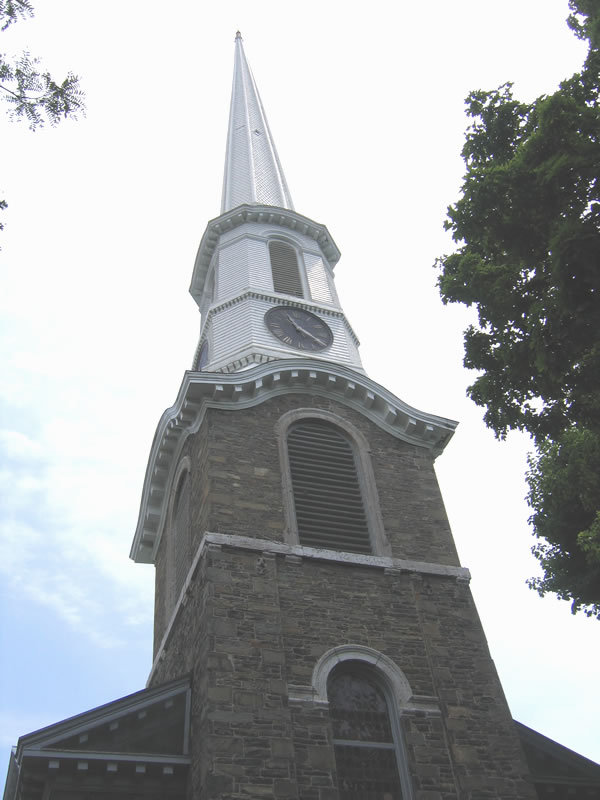
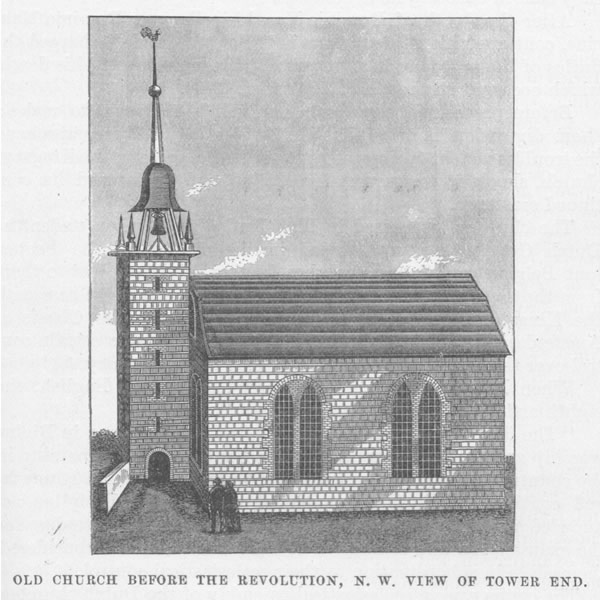
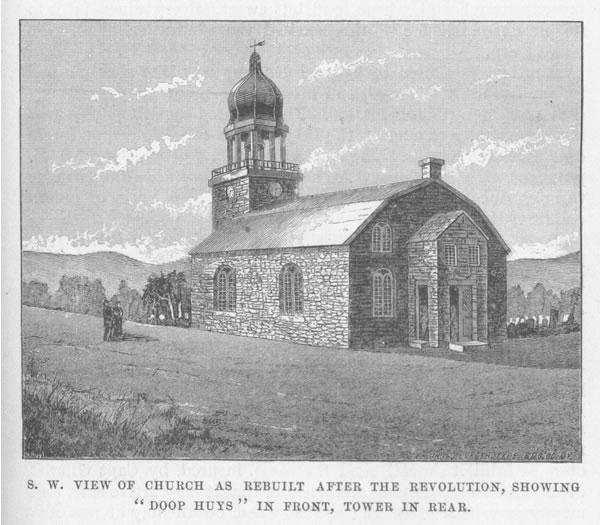

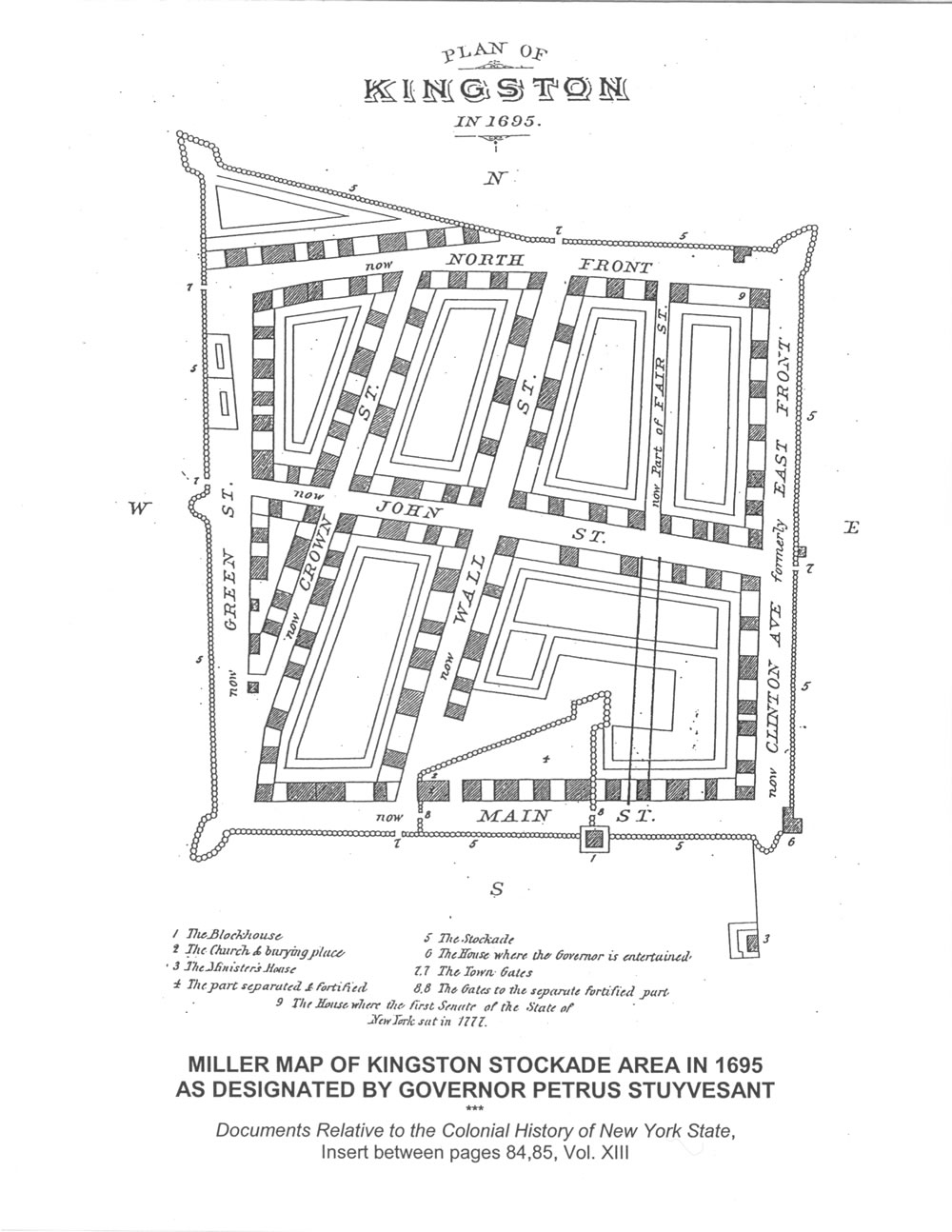
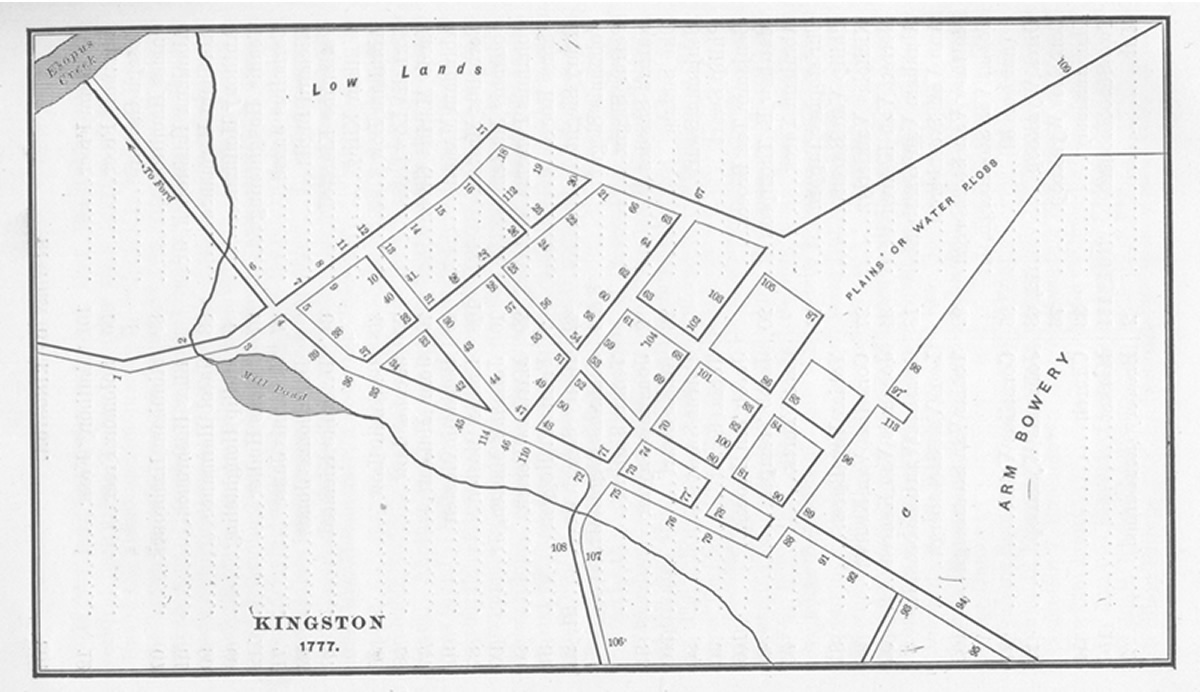

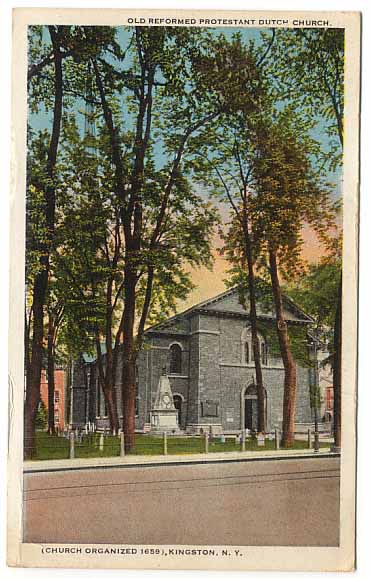
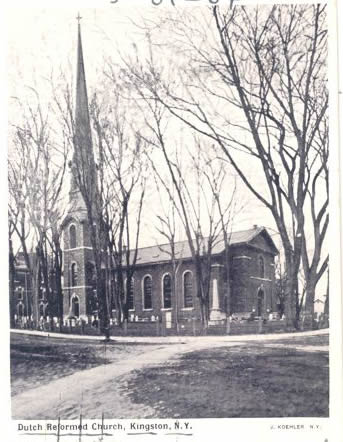
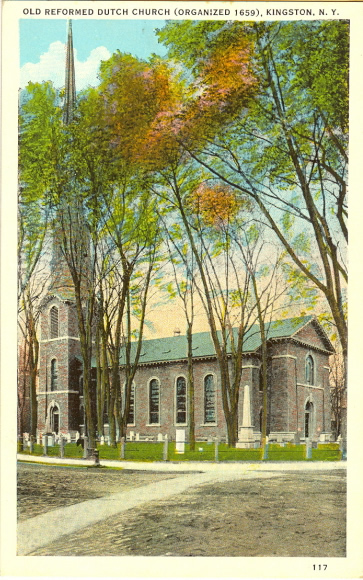
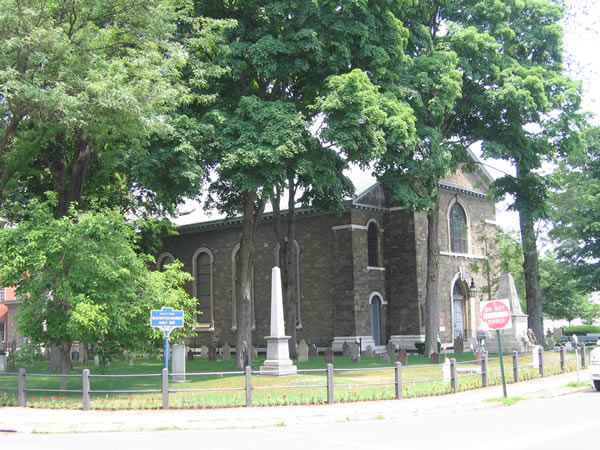
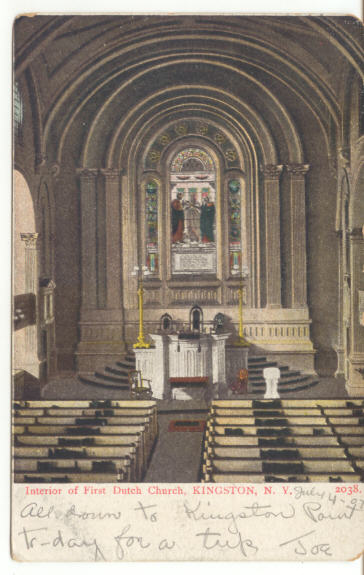
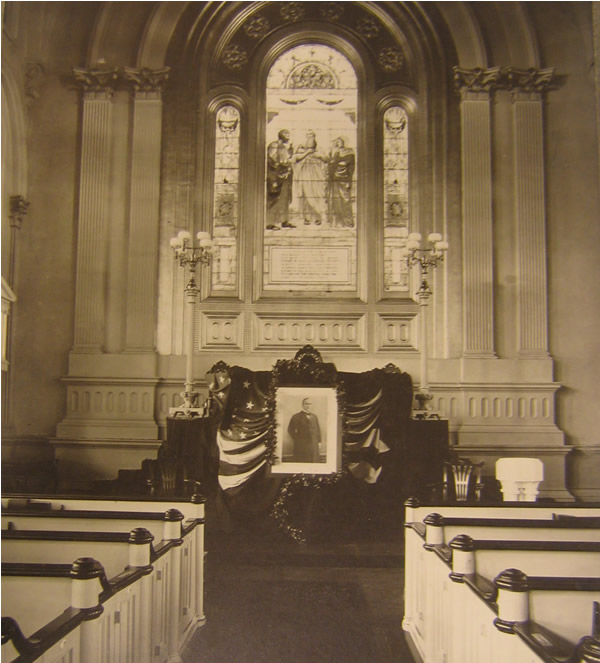
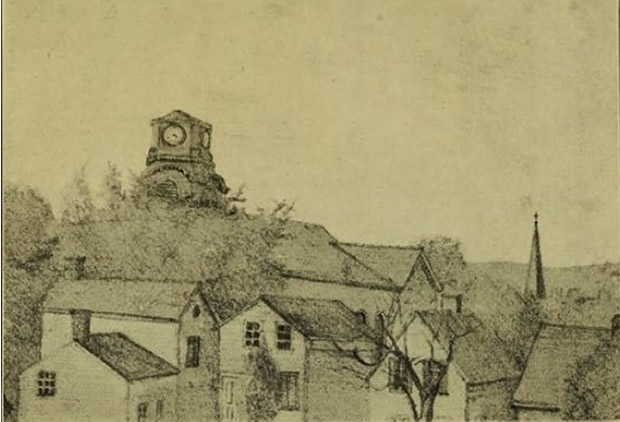


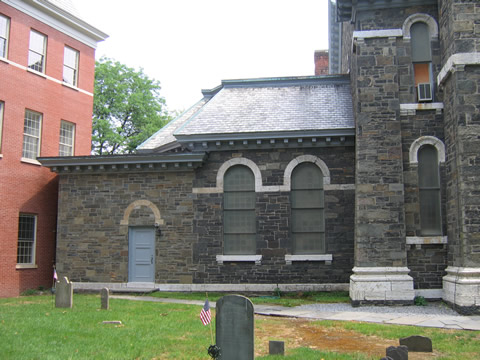

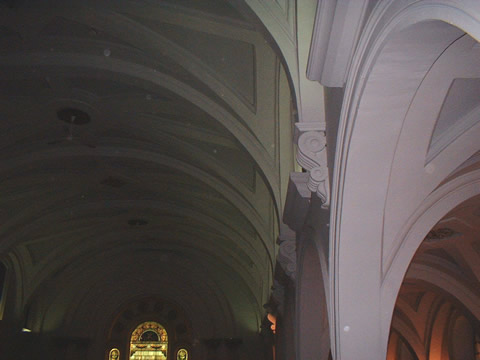
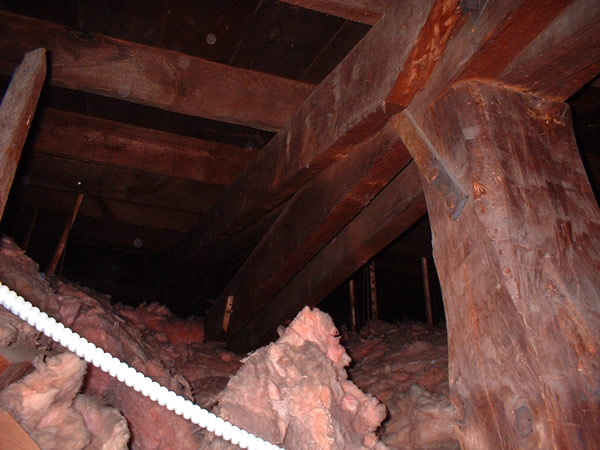

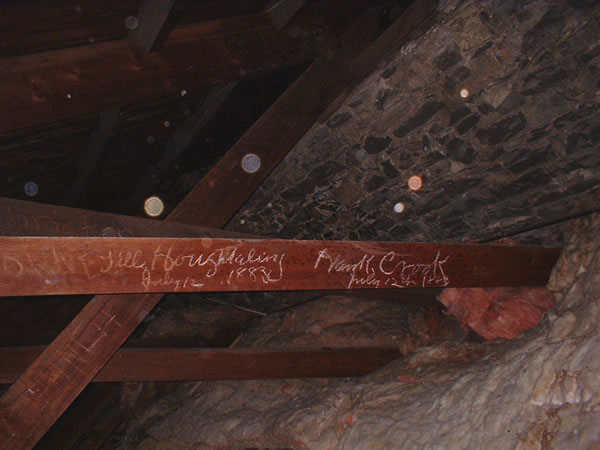
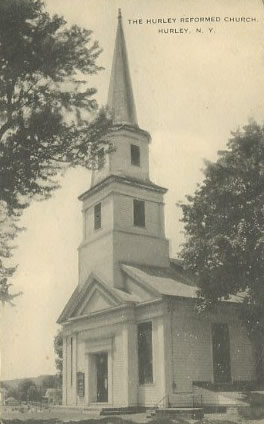

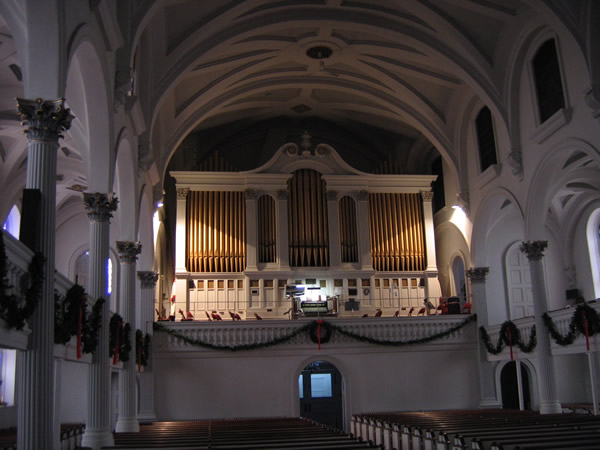
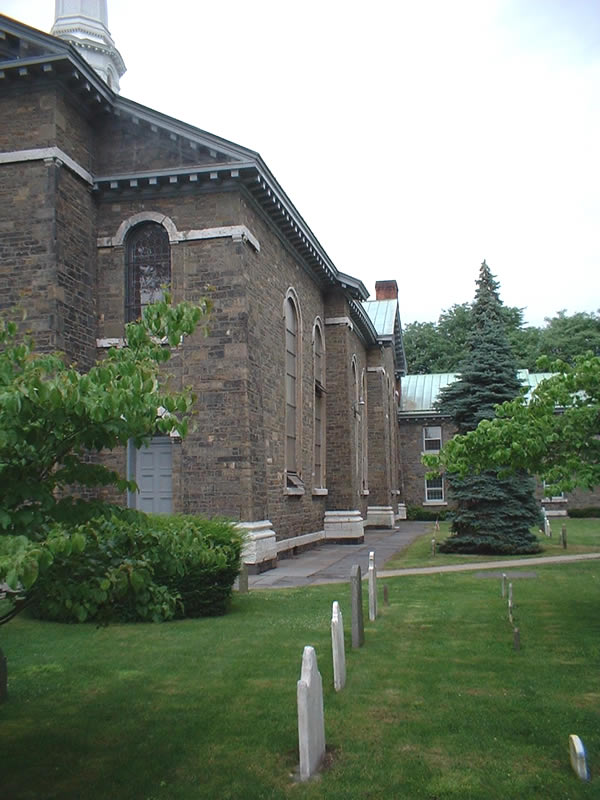
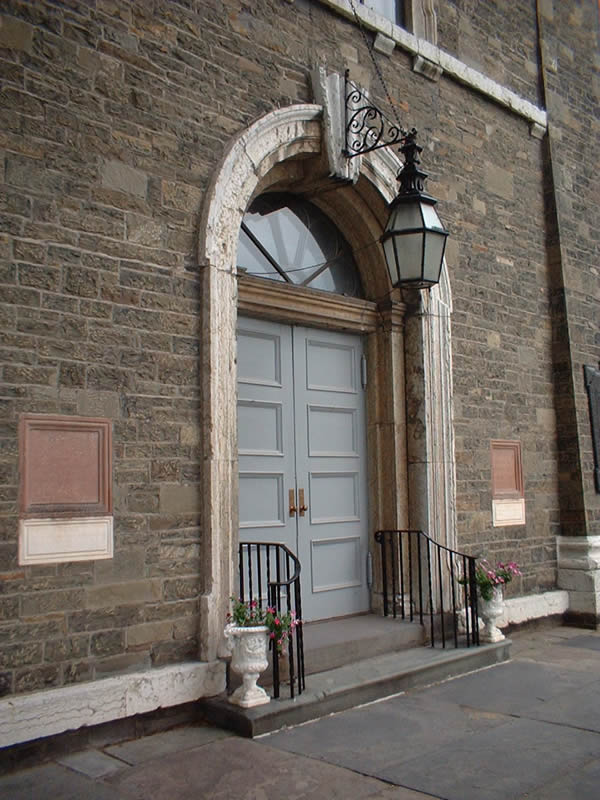

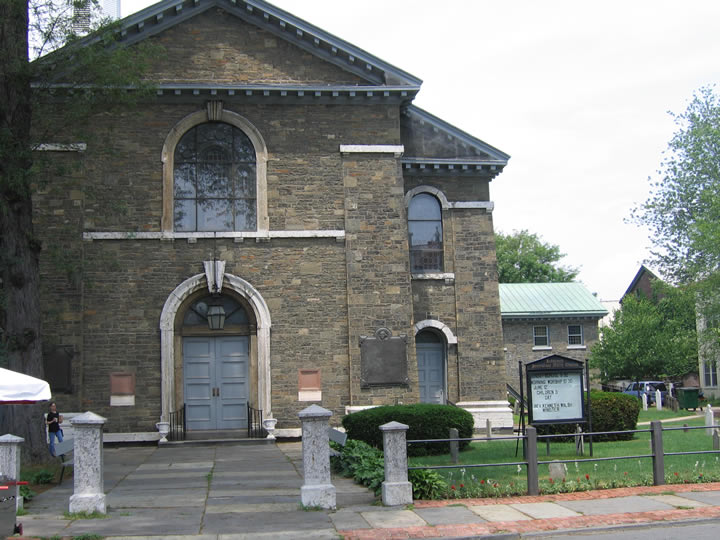
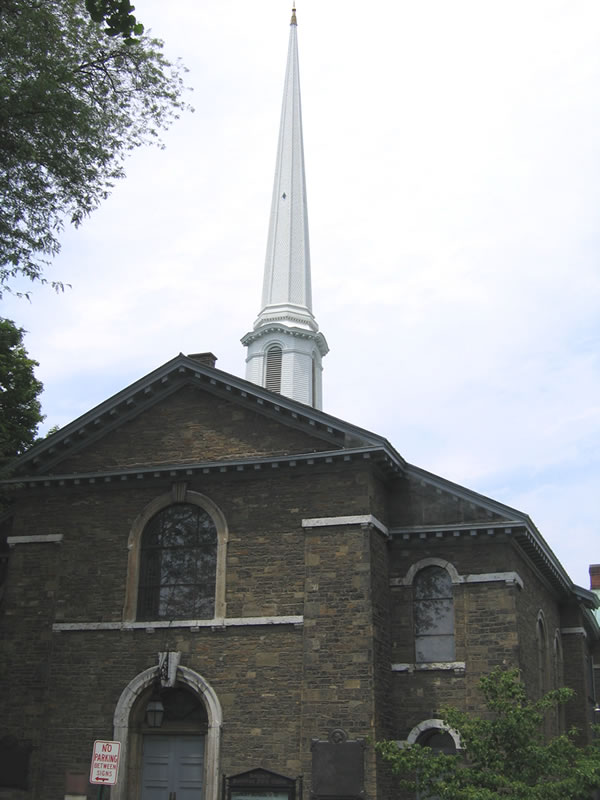
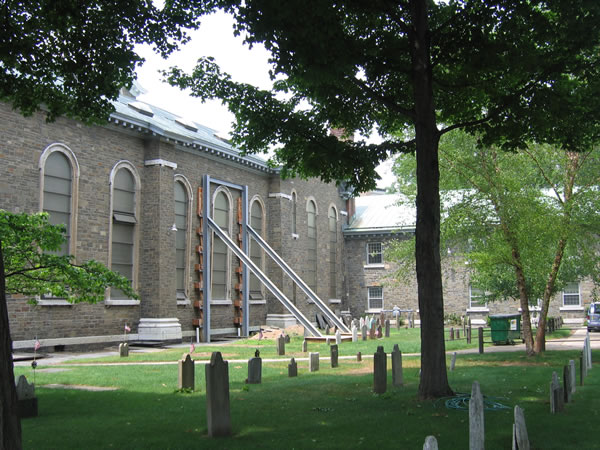
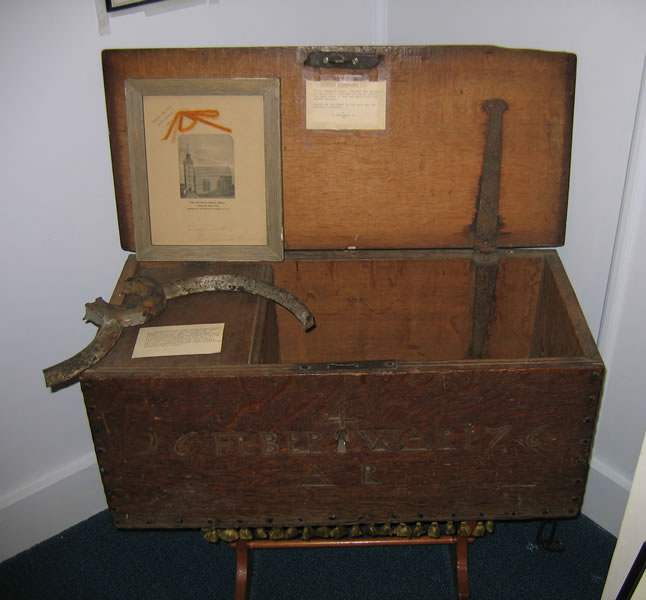
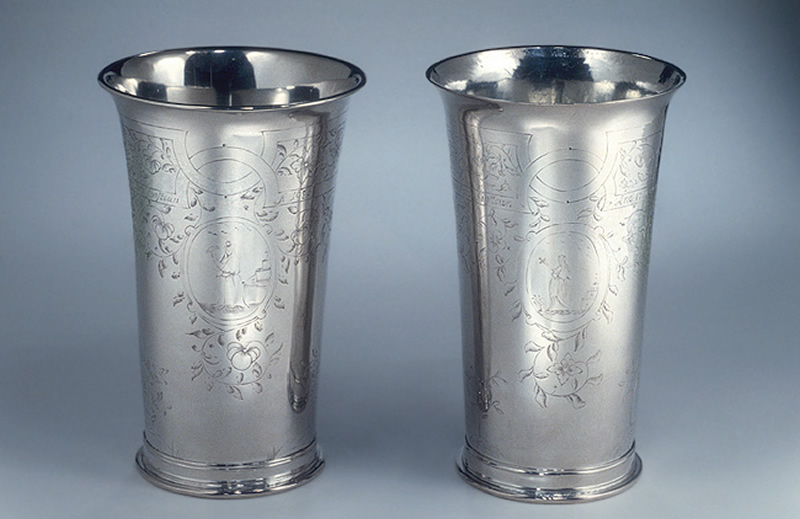
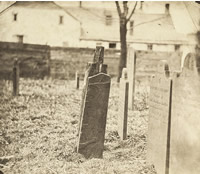
This photograph is believed to have been taken in the 1850’s, maybe even before the current church was built. The building in the background was demolished in 1869. Used with the permission of Gage DeWitt and Justin DeWitt with the DeWitt Family Historical Society.

This beautiful watercolor was painted in 2001 by a local Kingston artist - John Van Ness. Used with the permission of current owner Gary B. Faerber.
Overall: 7 3/16 in., 546 grams (18.3 cm, 17.554 troy ounces); Diam. of lip: 4 5/8 in. (11.7 cm); Diam. of base: 3 7/16 in. (8.7 cm)
Jointly owned by The Metropolitan Museum of Art and the Reformed Protestant Dutch Church, Kingston, N.Y., 1933 (33.120.621)
Overall: 7 1/4 in., 367.5 grams (18.4 cm, 11.816 troy ounces); Diam. of lip: 4 1/2 in. (11.4 cm); Diam. of base: 3 7/16 in. (8.7 cm)
Jointly owned by The Metropolitan Museum of Art and the Reformed Protestant Dutch Church, Kingston, N.Y., 1933 (33.120.622)
using information taken from;
____________________________________
16
- Feburwari -
76
A. R.
